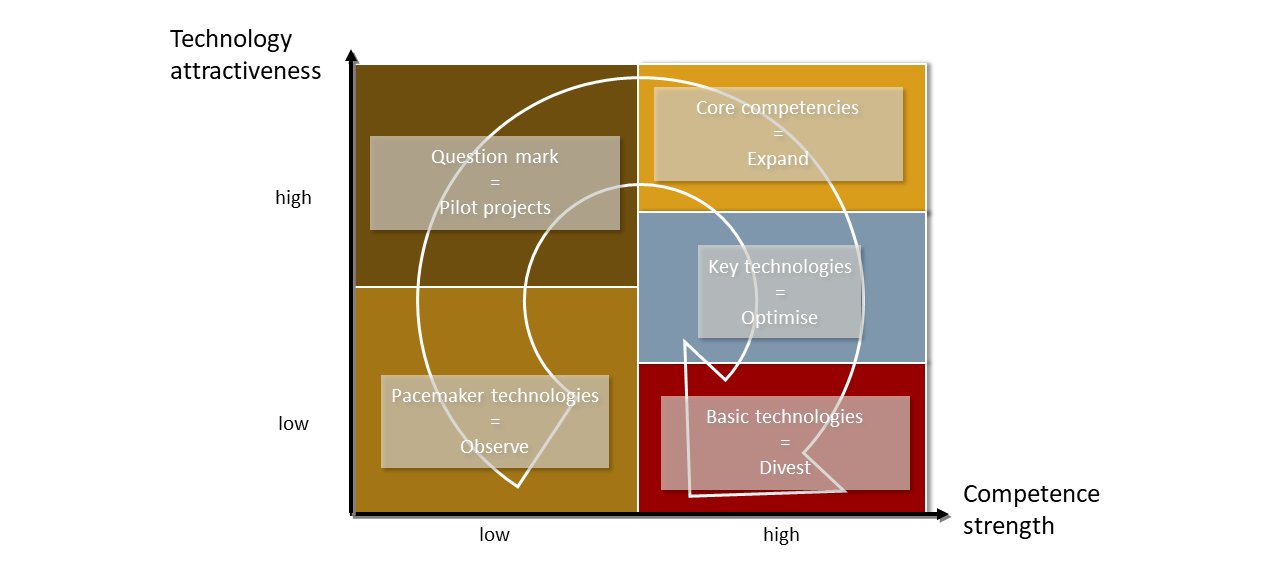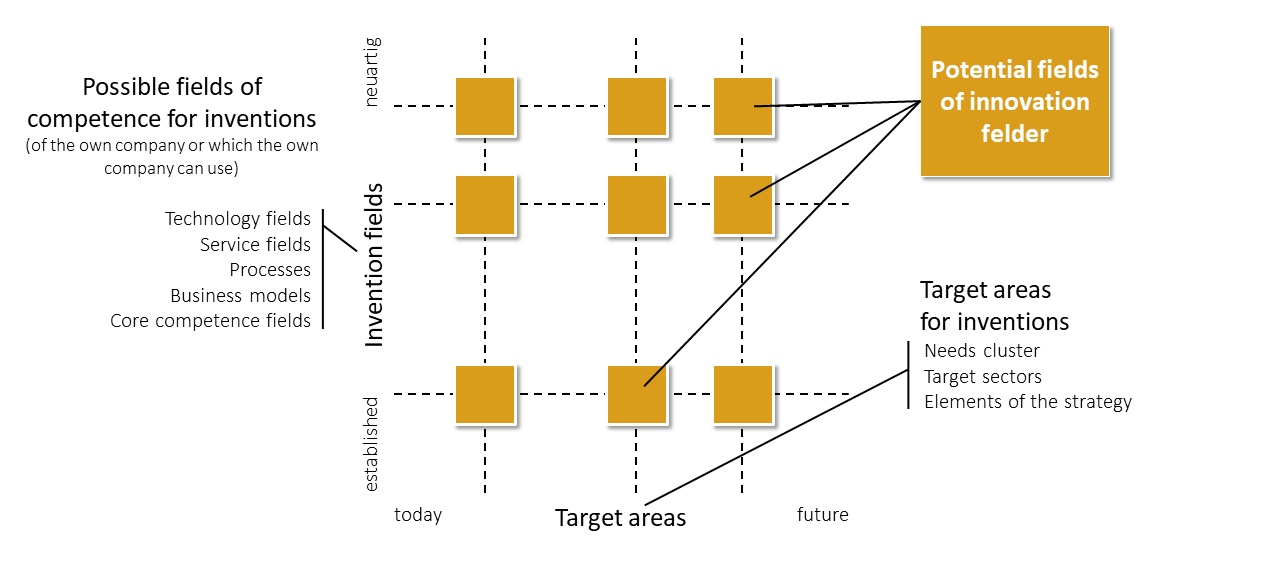Innovation management
A high capacity for innovation is an important success factor, especially for German companies, in order to survive in global competition. But innovations do not fall from the sky. A lot of chaff has to be separated from the wheat in a systematic process. In addition, targeted methods for generating ideas help to implement new approaches for solving customer requirements.

Innovation management and pre-development
Both elements belong together. Efficient innovation management without an efficient pre-development process makes just as little sense as vice versa. The goal is to obtain pre-developed technologies, concepts or even product components from both processes to such an extent that the product development based on them is not subject to any uncalculated risks. For it is precisely the risks that come from new technologies, in addition to poor planning, that often lead to delays in product development projects.
Above all, however, innovation management is about introducing differentiating features into products in a targeted and systematic way. The spectrum for such innovations is broad. On the one hand, the goal can be to offer customers new features. Or it may be a matter of using innovations to realise the same range of functions at lower manufacturing costs. But it is an open secret how difficult it is to realise new product ideas that generate enthusiasm among customers. In part, this is probably because true innovations can rarely be derived directly from customer needs. In retrospect, there are many examples of now established "innovations" that met with much scepticism even from the experts when they were first introduced (the personal computer is one such example).
Companies that want to support their market position with their innovative strength therefore need well-managed processes for innovation management and pre-development with a sufficient number of well-qualified resources. But what does the process look like in detail?
Trend and technology scouting
Systematic innovation management begins with the broadest possible view into the future. Therefore, innovation managers must be able to access sources of information that deal with future and technology trends. Examples include the Institute of future technology, Business Insider, Gardner, Forbes, the Technology Awards from Edison and Atlas or the Zukunftsinstitut (See figure). But the high-tech strategy of the German government as well as the USA or the European Union are also relevant sources. The volume of this information is enormous and therefore the work with it must be well prepared.
It is advisable to keep a trend radar with which the developments in the market and among customers can be observed and evaluated. The trends are assigned to different topics that are relevant for the company. These can be topics such as digitalisation, sustainability and individualisation. For this purpose, individual trends are mapped (e.g. Digital Twin or CO2 reduction) and it is determined whether the respective trend is relevant in the short, medium or long term. Accordingly, it is observed, considered or worked on.
Since innovations are also generated to a large extent by new technology offers, systematic technology scouting is required in parallel. In this process, the company defines relevant technology fields and systematically observes and evaluates the latest developments. Technology portfolios that map the life cycle of a technology and link it to standard strategies are suitable for a concise presentation of the information.
Technology portfolio of a technology field
The pictorial representation in the trend radar or technology portfolio represents the result of an intensive discussion between several areas in the company. Under the leadership of innovation management, product management, development and sales are usually involved. In addition, production and quality management could be relevant as needed.
Idea generation and evaluation
In addition to scouting, innovation management is about generating and evaluating ideas. We distinguish between uncontrolled idea generation and controlled idea generation. While in the former, spontaneously generated ideas are continuously recorded and evaluated, in controlled idea generation, tasks or search fields are specified for idea generation. This form of idea generation is a targeted, systematic process that represents a considerable amount of work. The core and starting point is the understanding of customer problems. On the one hand, these are issues that customers "complain about" because functionality is missing in a product or the product cannot be used optimally. Such issues can be worked out very well by observing customer behaviour and in dialogue. In addition, there are many innovations that arise from a forward-looking idea.
In any case, intensive customer observation and continuous dialogue is an important factor in finding good innovations.
With these two dimensions, on the one hand the target areas and on the other hand the competence fields for inventions, potential innovation fields are defined. Innovations are systematically developed in these fields. In interdisciplinary workshops, ideas are developed using suitable creativity techniques, which are then further developed in a structured process.
In order to make it possible to compare different ideas with each other, all ideas are evaluated using a catalogue of criteria. Based on these criteria, the ideas receive a scoring, which serves as the basis for deciding which idea will be steered into the pre-development process.
The pre-development process
With efficient trend and technology scouting combined with creative innovation management for idea generation and evaluation, important foundations for innovative products have been laid. But an essential part is still missing - the structured and systematic pre-development process: This is similar to the classic product development process (PDP). The purpose of this process is to validate the function of new technologies or concepts and to demonstrate the functional limits as well as the manufacturability and the associated manufacturing costs. This makes it possible to decide whether a technology should be used in a new product development. At the same time, risks are eliminated so that the subsequent product, module or platform development can be carried out on schedule.
Like the PDP, the pre-development process also contains gates that are used to control the maturity of the corresponding development. An interdisciplinary body, such as an innovation board, controls the various gates along the innovation management and the pre-development process. But an agile pre-development process with self-directed teams is also possible, in which case the members of the innovation board become stakeholders.
One of the great challenges in the field of innovation management and pre-development is to ensure the balancing act between the necessary creativity on the one hand and structured, process-oriented work on the other. A positive culture of innovation and a management that gives freedom are helpful here. In addition, it is necessary to allow mistakes. Especially in the environment of creative innovations, a lot has to be tried out and discarded. Holding on to concepts and ideas for too long can be just as wrong as giving up too early. Entrepreneurship and a sense of proportion are needed here.
The consultants at CO Improve will be happy to show you how you can establish these framework conditions for your innovation management and pre-development, from process, organisation and management to culture. We are happy to help!
Your benefit
- The innovation process is anchored in organisation, culture and leadership.
- Creativity and structured work are balanced and ensure success.
- Innovative products are a competitive advantage.




